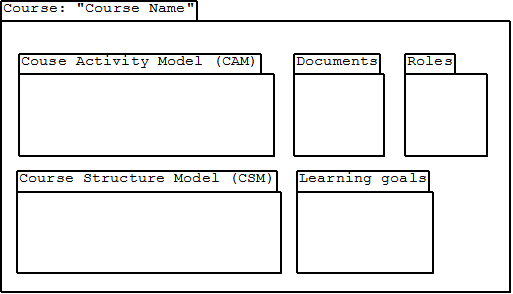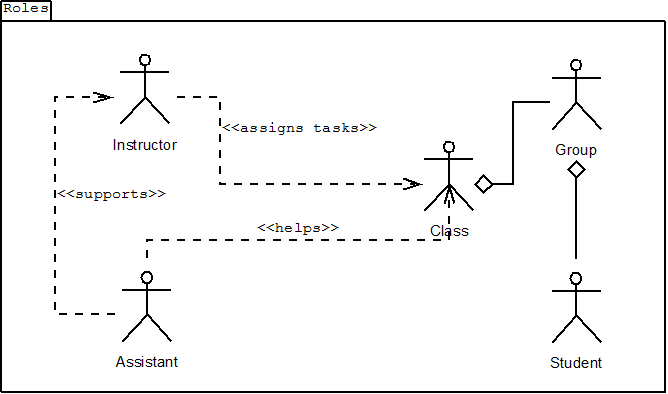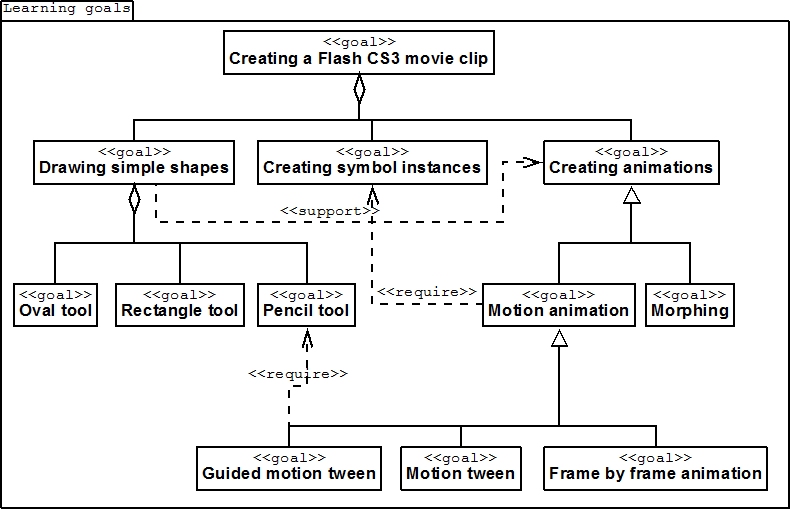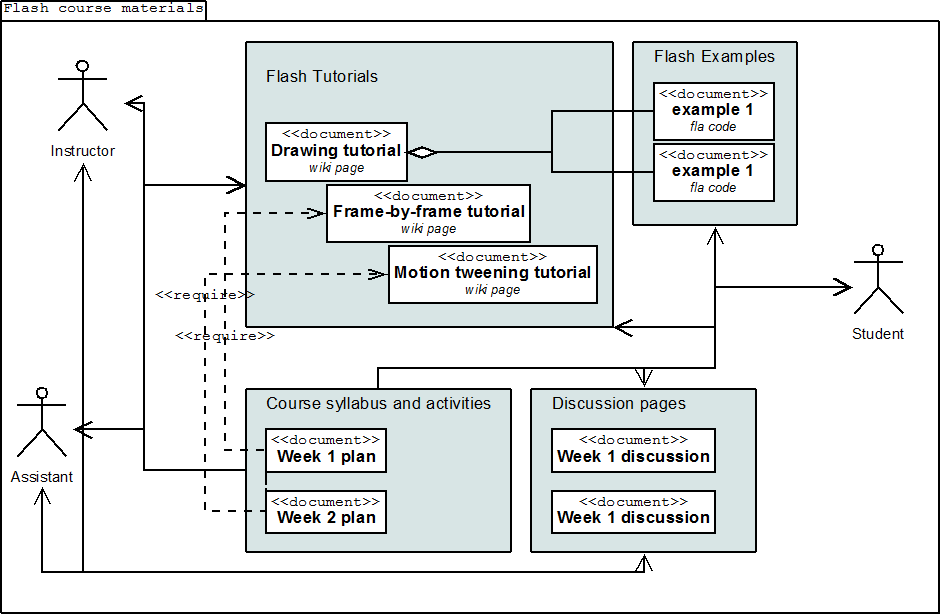« CoUML » : différence entre les versions
Aller à la navigation
Aller à la recherche
mAucun résumé des modifications |
mAucun résumé des modifications |
||
| Ligne 26 : | Ligne 26 : | ||
== Exemples == | == Exemples == | ||
{| border="2" | |||
|- | |||
! Course name | |||
|- | |||
| Summary || Description | |||
|- | |||
| Structure || Verbal Description of the blocks or modules, e.g. their number | |||
|- | |||
| Presence mode || List one or more of: blended, presential and on-line | |||
|- | |||
| Online support || Describes the learning environment and other tools | |||
|- | |||
| Participants || Number of students and their typical background. | |||
|- | |||
| Teaching staff || List of ... | |||
|- | |||
| Instructional strategy || Verbal description of a global strategy and the various types of module strategies (if there are) | |||
|- | |||
| coUML models || List of models used (same information as in the CPM class diagram. | |||
|+ Course package model fact sheet overview | |||
|} | |||
[[image:couml-cpm.png|frame|none|CPM Class diagram model]] | [[image:couml-cpm.png|frame|none|CPM Class diagram model]] | ||
Version du 20 janvier 2009 à 17:53
Cet article est une ébauche à compléter. Une ébauche est une entrée ayant un contenu (très) maigre et qui a donc besoin d'un auteur.
<pageby nominor="false" comments="false"/>
Définition
coUML est un langage de modélisation pédagogique basé sur UML.
Pour le moment, voir l'article dans edutechwiki Anglais.
Survol
coUML permet de modéliser le design d'un cours avec trois types d'artéfacts:
- Primaires
- Le course activity model (CAM) (modèle d'activités du cours) décrit les activités des participants avec un langage dérivé des diagrammes d'activité UML (c.f. en:UML activity diagram).
- Le course structure model (CSM) (modèle de la structure du cours) décrit les modules d'un cours et leur dépendances).
- Secondaires
- Le roles model (modèle des rôles) permet de décrire les rôles des participants et leurs relations
- Le goals model permet de décrir les objectifs pédagogiques et leurs dépendances
- Le documents model définit les documents produits et utilisés. Il est également possible d'attacher des rôles.
- Auxiliares
- Le course package model (CPM) est un simple tableau qui résume la description du cours avec une dizaine d'éléments.
Exemples
| Course name | |
|---|---|
| Summary | Description |
| Structure | Verbal Description of the blocks or modules, e.g. their number |
| Presence mode | List one or more of: blended, presential and on-line |
| Online support | Describes the learning environment and other tools |
| Participants | Number of students and their typical background. |
| Teaching staff | List of ... |
| Instructional strategy | Verbal description of a global strategy and the various types of module strategies (if there are) |
| coUML models | List of models used (same information as in the CPM class diagram. |
Liens
- Beauty and Precision in Instructional Design (slides). Derntl, Michael; Pat Parrish & Luca Botturi, EdMedia 2008.
- The Person-Centered e-Learning Pattern Repository. If you browse through this site, you will find several kinds of diagrams, in particular en:UML activity diagrams that describe various kinds of pedagogical scenarios. Since the first publication about coUML is more recent, some of these diagrams may not be fully coUML compatible, but I don't know. Anyhow, look at this website if you are interested in modeling various kinds of educational scenarios and teaching models - Daniel K. Schneider 11:11, 16 January 2009 (UTC)
Bibliographie
- Derntl Michael & Renate Motschnig (2007). coUML - A Visual Language for Modeling Cooperative Environments. in L. Botturi & T. Stubbs, Handbook of Visual Languages for Instructional Design: Theories and Practices, Information Science Reference, 155-184. ISBN 1599047292. (This handbook is fairly expensive and there don't seem to be alternatives for the moment to learn about coUML, except looking at somewhat older publications and the The Person-Centered e-Learning Pattern Repository we site.
- Botturi, Luca; Daniel Burgos, Manuel Caeiro, Michael Derntl, Rob Koper, Patrick Parrish, Tim Sodhi, Colin Tattersal (2007). Comparing Visual Instructional Design Languages, A Case Study, in L. Botturi & T. Stubbs, Handbook of Visual Languages for Instructional Design: Theories and Practices, Information Science Reference, 155-184. ISBN 1599047292
- Derntl, M. & Botturi, L. (2006). Essential Use Cases for Pedagogical Patterns. Computer Science Education, 16 (2), 137-156
- Derntl, M. & Motschnig-Pitrik, R. (2005). The Role of Structure, Patterns, and People in Blended Learning. The Internet and Higher Education, 8 (2), 111-130
- Derntl, M., & Motschnig-Pitrik, R. (2003). Employing Patterns for Web-Based, Person-Centered Learning: Concept and First Experiences. Proceedings of ED-MEDIA 2003 - World Conference on Educational Multimedia, Hypermedia & Telecommunications, Honolulu, HI, USA.
- Motschnig-Pitrik, R., & Derntl, M. (2005). Learning Process Models as Mediators between Didactical Practice and Web Support. Proceedings of Conceptual Modeling - ER 2005: 24th International Conference on Conceptual Modeling, Klagenfurt, Austria, LNCS 3716, Springer Verlag, pp. 112-127.




